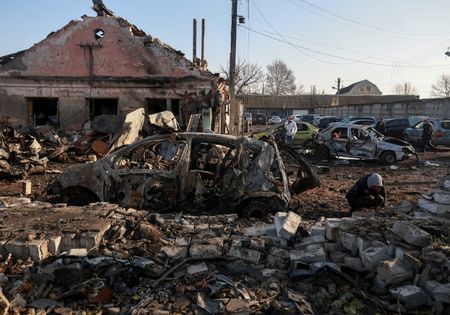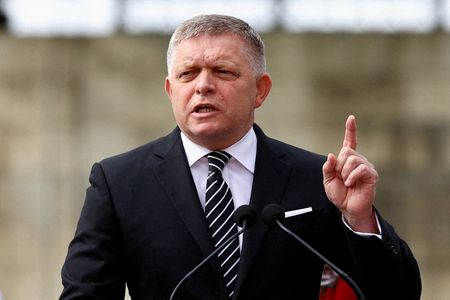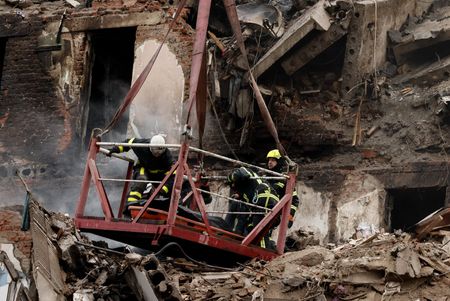By Andrew Osborn
MOSCOW (Reuters) -The United States has drafted a 28-point peace plan for ending the war in Ukraine which is being studied by Kyiv, Moscow and interested countries in Europe.
The plan, seen by Reuters, gives Russia – which is inching forward on the battlefield and controls almost one-fifth of Ukraine – much of what it wants.
But it also contains some unappetising proposals for Moscow which would leave it short of fully achieving its stated war aims and require its forces to pull back from some areas that they have captured.
Following are some of the points that are likely to prove contentious.
TERRITORY
Under the proposals, Ukraine would have to cede the rest of the Donetsk region to Russia, a large area including the fortress cities of Sloviansk and Kramatorsk, which Ukraine still controls.
Ukrainian President Volodymyr Zelenskiy has previously ruled out gifting Moscow any territory.
The agreement would also permanently lock in Russia’s battlefield gains since February 2022 in the four Ukrainian regions it claims as its own – Luhansk, Zaporizhzhia, Kherson and Donetsk. Russia’s 2014 annexation of Crimea would become permanent too.
Ukraine would also have to compromise on the status of the Russian-controlled Zaporizhzhia nuclear power station, which would be restarted and its power shared 50-50 between Russia and Ukraine.
But recognition of those territories as Russian would be “de facto” – a status that Moscow might not want to accept.
Russia would be left without full control of Kherson and Zaporizhzhia, where a line would be drawn along the current front line freezing the status quo.
Russian troops would not be allowed to garrison the part of Donetsk that Ukraine would hand over. This would become a neutral demilitarised buffer zone controlled by and belonging to Moscow.
Russian forces would also have to withdraw from two other regions where they have taken territory – Kharkiv and Dnipropetrovsk.
Moscow says its forces have captured the city of Kupiansk in the Kharkiv region although Kyiv has denied this. Under the U.S. proposals, Moscow would have to retreat from Kupiansk.
MONEY
Western governments have frozen about $300 billion of Russian assets, mostly in Europe, to punish Moscow for the war.
Russia wants those assets unfrozen and has threatened action against the European Union, which has produced a plan to issue a loan to Ukraine using cash balances accrued from the frozen securities.
But under the U.S. plan, Russia would have to hand over $100 billion to Washington which would lead an effort to rebuild Ukraine, with the U.S. reaping 50% of the profits from that work.
Another chunk of the frozen Russian assets would be ploughed into a joint U.S.-Russia investment vehicle, from which Moscow would get some benefit.
But the plan would give neither Russia nor Ukraine an entirely free hand when it comes to spending the frozen funds.
It could also torpedo EU plans to use the frozen funds to help Kyiv, though Russia would not get immediate relief from international sanctions: sanctions would be lifted in phases and on a case-by-case basis after discussions.
Ukraine would be forced to swallow a bitter pill by not being able under the plan to seek reparations for war damage from Russia through the courts.
SECURITY
Under the plan, Zelenskiy would have to permanently drop one of his most cherished ambitions – for Ukraine to join the U.S.-led NATO military alliance. NATO would agree to never admit Ukraine and the Ukrainian constitution would be amended to reflect that.
NATO itself would commit not to expand further, a key Russian demand, while there would be an “expectation” that Moscow would not invade its neighbours, cemented in a non-aggression pact between Russia and Ukraine and Europe.
Ukraine is likely to be disappointed by the vague language on the security guarantees it would receive from Washington. Beyond calling them “robust” and saying Kyiv would have to pay for them, there is no mention of what they might entail.
NATO troops could not be stationed in Ukraine, and Kyiv would have to commit to not becoming a nuclear-armed state under the proposals.
Ukraine would also be forced to cap the size of its army at 600,000 troops. It has previously resisted suggestions the size of its military should be limited.
The 600,000 figure is considerably less than the roughly 1 million people Ukraine says it has under arms. Russia has previously demanded Ukraine’s army be cut to below 100,000 troops.
JUSTICE
Ukrainian politicians have long talked about holding Russia accountable for its actions, but under the plan Kyiv would have to drop plans to pursue any legal cases seeking to prove that Moscow committed war crimes, something Russia denies.
Ukraine may also dislike proposals that would see Russia readmitted to the Group of Eight nations and re-integrated into the global economy.
Another clause talks of large-scale investment and business cooperation between the U.S. and Russia in areas such as rare earths, energy and the Arctic.
The plan also says Ukraine must be “de-Nazified,” a reference to what Moscow says are nationalist anti-Russian military units and politicians. Kyiv says this portrayal is bogus.
The plan, without referencing Ukraine, says “all Nazi ideology or activity should be renounced or forbidden.”
(Reporting by Andrew Osborn, Editing by Timothy Heritage)










